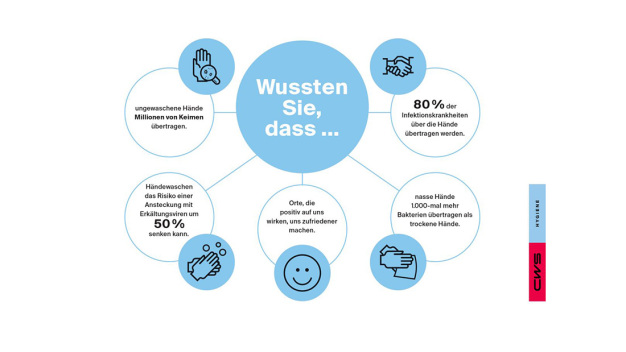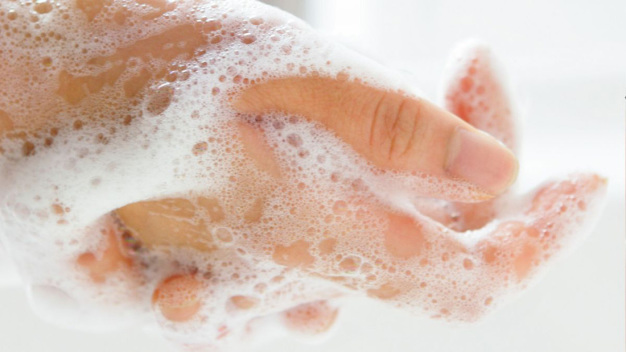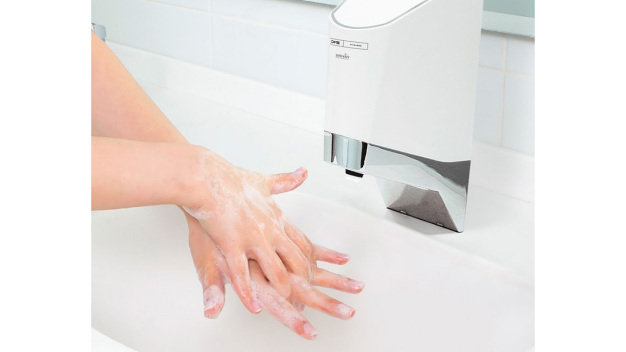- Bekleidung & Verbrauchsmaterial
Effizientes Hygienemanagement senkt Krankheitsraten und Kosten
Es ist noch zu früh, abschließende Lehren aus der Corona-Krise zu ziehen. Eines aber ist jetzt schon klar: Hygiene ist ein Wirtschaftsfaktor, der alle Branchen betrifft, nicht nur den Gesundheits- und Lebensmittelsektor. Darüber hinaus wird deutlich, dass Dienstleister systemrelevant sind, die bislang nicht als solche wahrgenommen wurden. „Die Pandemie führt uns deutlich vor Augen, was vorher galt und auch in Zukunft gelten wird“, sagt Jürgen Höfling, CEO der CWS Group. „Mangelnde Hygiene, vor allem mangelnde Handhygiene, verursacht enorme wirtschaftliche Schäden. Zulieferer und Dienstleister, die für mehr Hygiene sorgen, müssen als systemrelevant anerkannt werden, um im Notfall die Versorgung über Grenzen hinweg aufrecht halten zu können.“
Die Zahlen sprechen für sich: Infolge von Krankheiten, etwa durch Ausfalltage, entstehen den Unternehmen in Deutschland jährlich Kosten in Höhe von ca. 130 Mrd. Euro. Das sind rund 3.600 Euro pro Arbeitnehmer. Ein Großteil der Fehlzeiten geht auf Erkältungskrankheiten zurück. Grippeviren zum Beispiel können entgegen landläufiger Meinung das ganze Jahr über auftreten. Wie COVID-19 werden 90 Prozent aller Erkältungskrankheiten durch Viren ausgelöst. Und genau wie das Corona-Virus, werden laut WHO die Erreger von bis zu 80 Prozent aller Infektionskrankheiten durch Berührungen mit den Händen übertragen.
Viel Verbesserungspotenzial
Diese Zahl – 80 Prozent – macht deutlich, wie wichtig gerade die Handhygiene ist. Regelmäßiges und richtiges Händewaschen kann das Ansteckungsrisiko bei Erkältungskrankheiten um 50 Prozent senken. „Die Bedeutung des Händewaschens dürfte im Zuge der Corona-Pandemie inzwischen jeder verstanden haben“, sagt Jürgen Höfling. „Unternehmen sollten aber generell alles dafür tun, dass sich Ihre Mitarbeiter besser vor Ansteckungen durch Viren und Bakterien schützen.“
In dieser Hinsicht besteht noch enormer Verbesserungsbedarf. Nach einem Toilettenbesuch können sich auf jedem Quadratzentimeter der Hand mehr als 30 Millionen Bakterien ansammeln. Aber: 38,7 Prozent aller Beschäftigten in Büros waschen sich nach dem Toilettengang nicht die Hände, und nur 30 Prozent nutzen dazu Seife. Zudem trocknen sich viele nach dem Waschen die Hände nicht richtig ab. Nasse Hände können jedoch ca. 1.000 Mal mehr Bakterien übertragen als trockene. Jede kontaminierte Hand wiederum verteilt Viren oder Bakterien im Durchschnitt auf mehr als fünf Flächen: auf Türklinken, Computermäusen, Tastaturen, Kugelschreiber, Werkzeugen, Armlehnen und vielem mehr. Hier bleiben sie auf den Oberflächen bis zu 48 Stunden und auch länger aktiv.
Was kann jedes Unternehmen konkret tun?
Die gute Nachricht lautet: Eine wirksame Handhygiene ist ganz einfach: Gründliches Waschen mit Seife reicht aus, um Viren und Bakterien von der Hand zu entfernen. Es vermeidet, dass Keime über die Schleimhäute von Augen, Nase und Mund in den Körper geschleust werden. CWS rät daher allen Unternehmen zu drei Maßnahmenpaketen:
1. Aufklärung über korrekte Handhygiene in jedem Betrieb. Die Firmen sollten – etwa über Aushänge in Waschräumen – über die Notwendigkeit und die richtige Art des Händewaschens informieren. Das betrifft die Anlässe (z. B. nach dem Toilettengang, vor dem Essen) aber auch die Dauer (20 bis 30 Sekunden) und die Technik (Einreiben sämtlicher Handflächen, immer mit Seife, gründliches Abtrocknen).
2. Bereitstellung von Seife und Einmalhandtüchern in ausreichender Menge in allen relevanten Bereichen. Wenn möglich, sollte man an Waschbecken Systeme nutzen, die Wasser und Seifen bereits vorgemischt ausgeben und die sich berührungsfrei bedienen lassen. Einmalhandtücher müssen keine Papierprodukte zum Wegwerfen sein. Nachhaltiger und umweltfreundlicher sind wiederverwendbare Stoffrollen. Retraktive Handtuchspender sorgen mit ihren 2-Kammern-Systemen dafür, dass bereits benutzte Abschnitte von den sauberen getrennt bleiben. Das Bundesamt für Bevölkerungsschutz und Katastrophenhilfe stuft die Verwendung textiler Einmal-Systeme im „Handbuch Betriebliche Pandemieplanung“ ausdrücklich als tauglich für die Handhygiene ein.
3. Einsatz von Desinfektionsmitteln nur dort, wo das Händewaschen mit Wasser und Seife nicht möglich ist. Auch hier sind Anleitungen zu richtiger Dosierung, Dauer und Einreibetechnik empfehlenswert, denn das Mittel muss sorgfältig und ausreichend lang einmassiert werden, um zu wirken. Während der Pandemie sollten Desinfektionsmittel vorrangig den gesundheitsrelevanten Unternehmen sowie Risikogruppen vorbehalten bleiben.
Fazit:
Hygiene als wesentlicher Teil von Arbeitsschutz und Gesundheitsprävention sollte Chefsache sein – in allen Branchen. Damit Seifen und Desinfektionsmittel sowie weitere Hygieneprodukte rechtzeitig geliefert werden können, ist es daneben von größter Wichtigkeit, dass Zulieferer als systemrelevant eingestuft werden. „Die Pandemie macht Menschen krank, aber auch die Wirtschaft“, sagt Jürgen Höfling. „Ein Grund mehr, eine rasche konjunkturelle Erholung durch relativ einfache, betriebliche Hygienemaßnahmen zu unterstützen.“ Hierzu zählen auch Maßnahmen wie Mundschutz, transparente Trennwände an Countern und das Entschärfen weiterer Hygienelücken mittels berührungsloser Alternativen.
![]()
CWS Cleanrooms Deutschland GmbH & Co.KG
Dreieich Plaza 1 A
63303 Dreieich
Deutschland
Telefon: +49 6103 3091290
Telefax: +49 6103 309169
eMail: cleanrooms.de@cws.com
Internet: http://www.cws.com/reinraum












